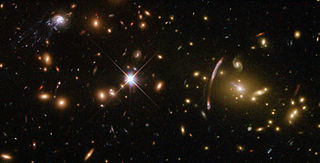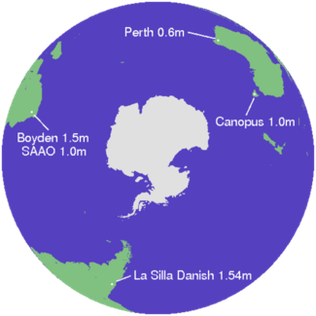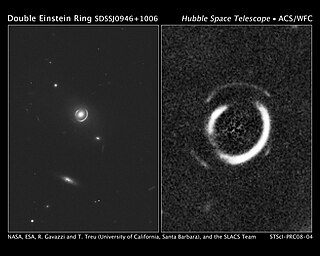 W
WA gravitational lens is a distribution of matter between a distant light source and an observer, that is capable of bending the light from the source as the light travels towards the observer. This effect is known as gravitational lensing, and the amount of bending is one of the predictions of Albert Einstein's general theory of relativity.
 W
WThe cosmic microwave background, in Big Bang cosmology, is electromagnetic radiation which is a remnant from an early stage of the universe, also known as "relic radiation". The CMB is faint cosmic background radiation filling all space. It is an important source of data on the early universe because it is the oldest electromagnetic radiation in the universe, dating to the epoch of recombination. With a traditional optical telescope, the space between stars and galaxies is completely dark. However, a sufficiently sensitive radio telescope shows a faint background noise, or glow, almost isotropic, that is not associated with any star, galaxy, or other object. This glow is strongest in the microwave region of the radio spectrum. The accidental discovery of the CMB in 1965 by American radio astronomers Arno Penzias and Robert Wilson was the culmination of work initiated in the 1940s, and earned the discoverers the 1978 Nobel Prize in Physics.
 W
W9Spitch is a gravitationally lensed system of two galaxies. The nearer galaxy is approximately 2 billion light-years (610 Mpc) from Earth and is designated SDSS J020941.27+001558.4, while the lensed galaxy is 10 billion light-years (3.1 Gpc) distant and is designated ASW0009io9. It was discovered in January 2014 by Zbigniew "Zbish" Chetnik, an amateur astronomer from Northamptonshire, England, while classifying images on the website Spacewarps.org. The discovery was announced on the BBC television programme Stargazing Live.
 W
WA1689-zD1 is a galaxy in the Virgo constellation cluster. It was a candidate for the most distant and therefore earliest-observed galaxy discovered as of February 2008, based on a photometric redshift.
 W
WAbell 1201 BGC is a massive elliptical galaxy residing as the brightest cluster galaxy of the Abell 1201 galaxy cluster. At a redshift of 0.169, this system is around 2.7 billion light years from Earth, and offset about 11 kiloparsecs from the X-ray peak of the intracluster gas. With an ellipticity of 0.32±0.02, the stellar distribution is far from spherical. In solar units, the total stellar luminosity is 4×1011 L☉ in SDSS r-band, and 1.6×1012 L☉ in 2MASS K-band. Half the stars orbit within an effective radius of 15 kpc, and their central velocity dispersion is about 285 km s−1 within 5 kpc rising to 360 km s−1 at 20 kpc distance.
 W
WAbell 1689 is a galaxy cluster in the constellation Virgo nearly 2.2 billion light-years away.
 W
WAbell 2667 is a galaxy cluster. It is one of the most luminous galaxy clusters in the X-ray waveband known at a redshift about 0.2.
 W
WThe Cosmic Horseshoe is the nickname given to a gravitationally lensed system of two galaxies in the constellation Leo.
 W
WThe Einstein Cross is a gravitationally lensed quasar that sits directly behind ZW 2237+030, Huchra's Lens. Four images of the same distant quasar appear around a foreground galaxy due to strong gravitational lensing. This system was discovered by John Huchra and coworkers in 1985.
 W
WAn Einstein ring, also known as an Einstein–Chwolson ring or Chwolson ring, is created when light from a galaxy or star passes by a massive object en route to the Earth. Due to gravitational lensing, the light is diverted, making it seem to come from different places. If source, lens, and observer are all in perfect alignment, the light appears as a ring.
 W
WIn general relativity, a point mass deflects a light ray with impact parameter by an angle approximately equal to
 W
WGravitational microlensing is an astronomical phenomenon due to the gravitational lens effect. It can be used to detect objects that range from the mass of a planet to the mass of a star, regardless of the light they emit. Typically, astronomers can only detect bright objects that emit much light (stars) or large objects that block background light. These objects make up only a minor portion of the mass of a galaxy. Microlensing allows the study of objects that emit little or no light.
 W
WThe galaxy cluster IRC 0218 hosts the most distant strong gravitational lensing galaxy currently known at a redshift of z = 1.62. The lens is one of the two brightest cluster galaxies and is lensing a background star-forming galaxy at a redshift of z = 2.26 into a bright arc and a faint counterimage. The lens was discovered through a combination of Hubble Space Telescope and Keck telescope imaging and spectroscopy. The discovery and subsequent analysis of the lens was published in the Astrophysical Journal Letters on June 23, 2014 by an international team of astronomers led by Dr. Kim-Vy Tran from Texas A&M University in College Station, Texas and team members Dr. Kenneth Wong and Dr. Sherry Suyu from the Academia Sinica Institute of Astronomy and Astrophysics in Taipei, Taiwan.
 W
WJ1000+0221 was the most distant gravitational lens galaxy known, and remains the most distant quad-image lens galaxy discovered so far. The measured distance the light has traveled, including the lensed deflection, is 9.4 billion light years. A very recent discovery by a group of astronomers led by Dr Arjen Van der Wel from the Max Planck Institute for Astronomy in Heidelberg, Germany, the results of which are accepted for publication on October 21, 2013 in the Astrophysical Journal Letters (arXiv.org). Using NASA’s Hubble Space Telescope, the astronomers discovered this quadruple gravitational lens dubbed J1000+0221 which would provide a further test for Einstein's theory of general relativity. These gravitational lenses also serve as light magnification tools that help astronomers to look at distant galaxies thus acting as a natural telescope.
 W
WMACS J1149 Lensed Star 1, also known as Icarus, is a blue supergiant star observed through a gravitational lens. It is the most distant individual star to have been detected so far, at approximately 14 billion light-years from Earth. Light from the star was emitted 4.8 billion years after the Big Bang. According to co-discoverer Patrick Kelly, the star is at least a hundred times more distant than the next-farthest non-supernova star observed, SDSS J1229+1122, and is the first magnified individual star seen.
 W
WMicrolensing Observations in Astrophysics (MOA) is a collaborative project between researchers in New Zealand and Japan, led by Professor Yasushi Muraki of Nagoya University. They use microlensing to observe dark matter, extra-solar planets, and stellar atmospheres from the Southern Hemisphere. The group concentrates especially on the detection and observation of gravitational microlensing events of high magnification, of order 100 or more, as these provide the greatest sensitivity to extrasolar planets. They work with other groups in Australia, the United States and elsewhere. Observations are conducted at New Zealand's Mt. John University Observatory using a 1.8 m (70.9 in) reflector telescope built for the project.
 W
WMOA-2009-BLG-387L is a red dwarf in the Sagittarius constellation that is host to the planet MOA-2009-BLG-387Lb. The star is estimated to be nearly 20,000 light years away and approximately one fifth the mass of the Sun, although large confidence intervals exist, reflecting the uncertainties in both the mass and distance. The star drew the attention of astronomers when it became the lens of gravitational microlensing event MOA-2009-BLG-387L, in which it eclipsed a background star and created distorted caustics, an envelope of reflected or refracted light rays. Analysis of the caustic events and of follow-up observational data led to the planet's discovery, which was reported in February 2011.
 W
WOGLE-2005-BLG-390L is a star thought to be a spectral type M. This dim magnitude 16 galactic bulge star is located in the Scorpius constellation at a far distance of about 21,500 light years.
 W
WOGLE-2006-BLG-109L is a dim magnitude 17 M0V galactic bulge star approximately 4,920 light-years away in the constellation of Scorpius.
 W
WThe Optical Gravitational Lensing Experiment (OGLE) is a Polish astronomical project based at the University of Warsaw that runs a long-term variability sky survey (1992-present). The main goals are the detection and classification of variable stars, discovery of microlensing events, dwarf novae, and studies of the structure of the galaxy and the Magellanic Clouds. Since the project began in 1992, it has discovered a multitude of extrasolar planets, together with the first planet discovered using the transit method (OGLE-TR-56b) and gravitational microlensing. The project has been led by professor Andrzej Udalski since its inception.
 W
WBohdan Paczyński or Bohdan Paczynski was a Polish astronomer notable in the theory of the stellar evolution, accretion discs, and gamma ray bursts.
 W
WThe Probing Lensing Anomalies NETwork (PLANET) collaboration coordinates a network of telescopes to rapidly sample photometric measurements of the magnification of stars in the galactic bulge undergoing gravitational microlensing by intervening foreground stars. This network consists of five 1m-class optical telescopes distributed in longitude around the southern hemisphere in order to perform quasi-continuous round-the-clock precision monitoring. On a target-of-opportunity basis, less frequent spectroscopic measurements complement the rapid photometry for selected prime targets. Since 2005, PLANET performs a common microlensing campaign with RoboNet-1.0, a network of UK-operated 2.0m robotic telescopes.
 W
WRelativistic images are images of gravitational lensing which result due to light deflections by angles .
 W
WSDSSJ0946+1006 is an unusual gravitational lens system consisting of three galaxies at distances of respectively three, six, and eleven billion light years from Earth. In a report presented at the 211th meeting of the American Astronomical Society, researchers Raphael Gavazzi and Tommaso Treu of the University of California, Santa Barbara described the discovery of a double Einstein ring produced by the gravitational lensing of light from two distant galaxies. The observations were made using the Hubble Space Telescope.
 W
WSN Refsdal is the first detected multiply-lensed supernova, visible within the field of the galaxy cluster MACS J1149+2223. It was given its nickname in honor of the Norwegian astrophysicist Sjur Refsdal, who, in 1964, first proposed using time-delayed images from a lensed supernova to study the expansion of the universe. The observations were made using the Hubble Space Telescope.
 W
WStrong gravitational lensing is a gravitational lensing effect that is strong enough to produce multiple images, arcs, or even Einstein rings. Generally, the strong lensing effect requires the projected lens mass density greater than the critical density, that is . For point-like background sources, there will be multiple images; for extended background emissions, there can be arcs or rings. Topologically, the multiple image production is governed by the odd number theorem.
 W
WThe Twin Quasar, was discovered in 1979 and was the first identified gravitationally lensed object. It is a quasar that appears as two images, a result from gravitational lensing caused by the galaxy YGKOW G1 that is located directly between Earth and the quasar.
 W
WWhile the presence of any mass bends the path of light passing near it, this effect rarely produces the giant arcs and multiple images associated with strong gravitational lensing. Most lines of sight in the universe are thoroughly in the weak lensing regime, in which the deflection is impossible to detect in a single background source. However, even in these cases, the presence of the foreground mass can be detected, by way of a systematic alignment of background sources around the lensing mass. Weak gravitational lensing is thus an intrinsically statistical measurement, but it provides a way to measure the masses of astronomical objects without requiring assumptions about their composition or dynamical state.